International Marketing, Innovation and E-commerce
VerifiedAdded on 2023/01/03
|9
|2142
|47
AI Summary
This report focuses on the marketing strategy adopted by Primark Stores Limited for enhancing their operations in the international market. It covers the STP approach, glocal strategies, marketing mix, product life cycle, and Boston Matrix.
Contribute Materials
Your contribution can guide someone’s learning journey. Share your
documents today.
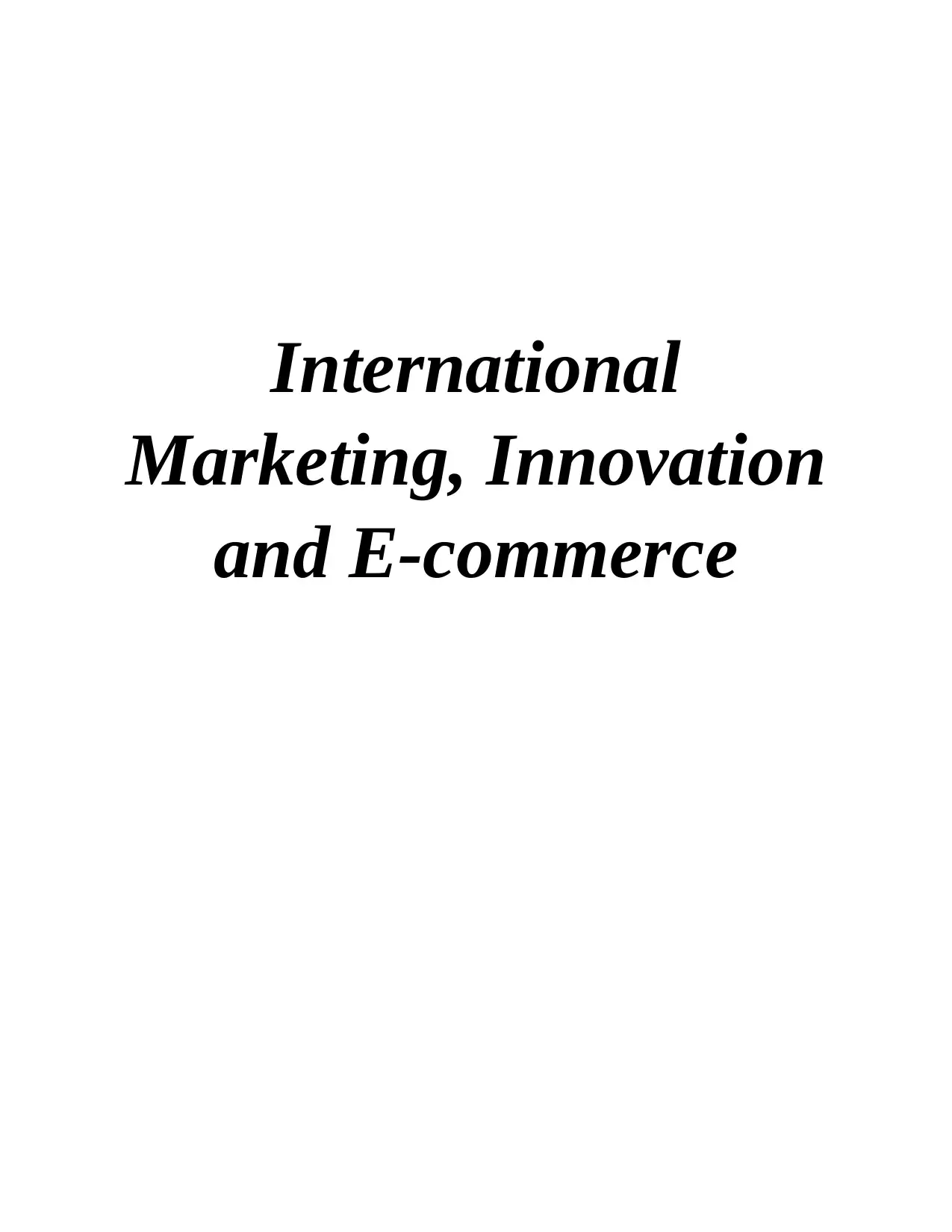
International
Marketing, Innovation
and E-commerce
Marketing, Innovation
and E-commerce
Secure Best Marks with AI Grader
Need help grading? Try our AI Grader for instant feedback on your assignments.
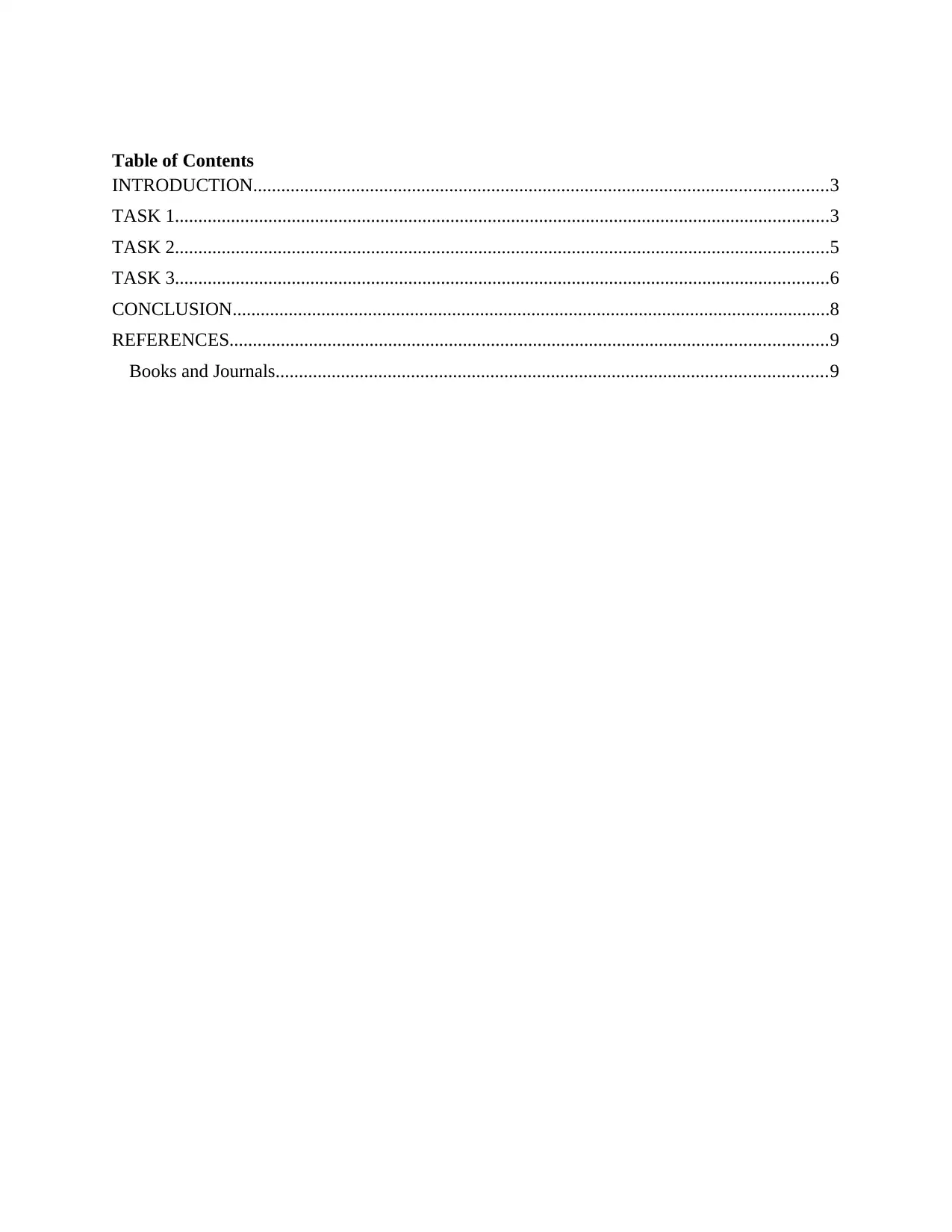
Table of Contents
INTRODUCTION...........................................................................................................................3
TASK 1............................................................................................................................................3
TASK 2............................................................................................................................................5
TASK 3............................................................................................................................................6
CONCLUSION................................................................................................................................8
REFERENCES................................................................................................................................9
Books and Journals......................................................................................................................9
INTRODUCTION...........................................................................................................................3
TASK 1............................................................................................................................................3
TASK 2............................................................................................................................................5
TASK 3............................................................................................................................................6
CONCLUSION................................................................................................................................8
REFERENCES................................................................................................................................9
Books and Journals......................................................................................................................9

INTRODUCTION
International marketing is a process of dealing the goods and services of the across
different countries in the world. The process includes certain stages namely; planning and
execution of rates, promotion of products and distribution of products effectively. E-commerce is
the process of selling the goods and services electronically through internet. This process
initiates the transfer of money and delivery of goods at the destination. This report mainly
focuses on the functioning of Primark Stores Limited which is an Irish fashion retail store
headquartered in Dublin, Ireland (Agarwal and Wu, 2018). This report mainly focuses on the
marketing strategy adopted by Primark Stores Limited for enhancing their operations. Moreover,
for this there is an analysis of STP approach of the company for international market.
Furthermore, this report considers the Glocal strategies and adaptation of the company in the
international environment. Lastly, it covers the marketing mix of the company which focuses on
the range of products offered by the company. It also covers the product life cycle and Boston
Matrix of the company.
TASK 1
Primark is a famous fashion retail which offers latest fashion styled clothes to their potential
customers. This company was founded by Arthur Ryan in 1969. The company offers a range of
products which also include the sale of makeup products. The company contribute to the
contemporary fashion trend by offering the products at lower prices to their customers. It
encourages customer to buy heaps of products and discard them after a few wears to come back
and buy new batch of outfits. STP approach is used to segment the targeted market which will be
helpful for the company to achieve their goals. It includes three stages which can be explained in
the context of Primark as follows:
Segmentation: International markets are formed through diversified customers and
dynamic companies. It is difficult for Primark to understand the expectations of the
customers and build a competitive edge over its competitors. The aim of Primark is to
target the customers group on the basis of their products (Baines, Rosengren and
Antonetti, 2017). Likewise if the company wants to sell baby products then they have to
segment the market on the basis of married people as they are the target of the company.
International marketing is a process of dealing the goods and services of the across
different countries in the world. The process includes certain stages namely; planning and
execution of rates, promotion of products and distribution of products effectively. E-commerce is
the process of selling the goods and services electronically through internet. This process
initiates the transfer of money and delivery of goods at the destination. This report mainly
focuses on the functioning of Primark Stores Limited which is an Irish fashion retail store
headquartered in Dublin, Ireland (Agarwal and Wu, 2018). This report mainly focuses on the
marketing strategy adopted by Primark Stores Limited for enhancing their operations. Moreover,
for this there is an analysis of STP approach of the company for international market.
Furthermore, this report considers the Glocal strategies and adaptation of the company in the
international environment. Lastly, it covers the marketing mix of the company which focuses on
the range of products offered by the company. It also covers the product life cycle and Boston
Matrix of the company.
TASK 1
Primark is a famous fashion retail which offers latest fashion styled clothes to their potential
customers. This company was founded by Arthur Ryan in 1969. The company offers a range of
products which also include the sale of makeup products. The company contribute to the
contemporary fashion trend by offering the products at lower prices to their customers. It
encourages customer to buy heaps of products and discard them after a few wears to come back
and buy new batch of outfits. STP approach is used to segment the targeted market which will be
helpful for the company to achieve their goals. It includes three stages which can be explained in
the context of Primark as follows:
Segmentation: International markets are formed through diversified customers and
dynamic companies. It is difficult for Primark to understand the expectations of the
customers and build a competitive edge over its competitors. The aim of Primark is to
target the customers group on the basis of their products (Baines, Rosengren and
Antonetti, 2017). Likewise if the company wants to sell baby products then they have to
segment the market on the basis of married people as they are the target of the company.
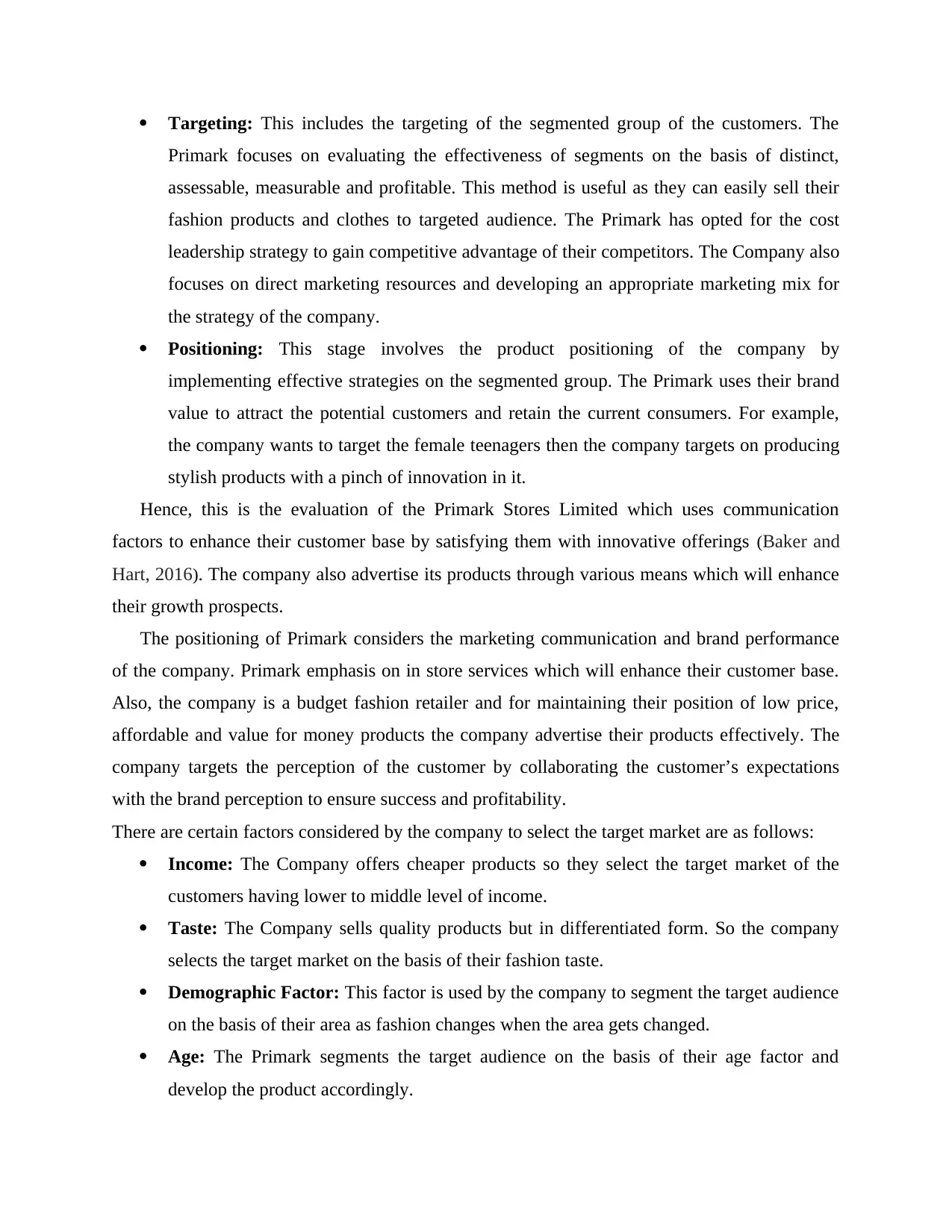
Targeting: This includes the targeting of the segmented group of the customers. The
Primark focuses on evaluating the effectiveness of segments on the basis of distinct,
assessable, measurable and profitable. This method is useful as they can easily sell their
fashion products and clothes to targeted audience. The Primark has opted for the cost
leadership strategy to gain competitive advantage of their competitors. The Company also
focuses on direct marketing resources and developing an appropriate marketing mix for
the strategy of the company.
Positioning: This stage involves the product positioning of the company by
implementing effective strategies on the segmented group. The Primark uses their brand
value to attract the potential customers and retain the current consumers. For example,
the company wants to target the female teenagers then the company targets on producing
stylish products with a pinch of innovation in it.
Hence, this is the evaluation of the Primark Stores Limited which uses communication
factors to enhance their customer base by satisfying them with innovative offerings (Baker and
Hart, 2016). The company also advertise its products through various means which will enhance
their growth prospects.
The positioning of Primark considers the marketing communication and brand performance
of the company. Primark emphasis on in store services which will enhance their customer base.
Also, the company is a budget fashion retailer and for maintaining their position of low price,
affordable and value for money products the company advertise their products effectively. The
company targets the perception of the customer by collaborating the customer’s expectations
with the brand perception to ensure success and profitability.
There are certain factors considered by the company to select the target market are as follows:
Income: The Company offers cheaper products so they select the target market of the
customers having lower to middle level of income.
Taste: The Company sells quality products but in differentiated form. So the company
selects the target market on the basis of their fashion taste.
Demographic Factor: This factor is used by the company to segment the target audience
on the basis of their area as fashion changes when the area gets changed.
Age: The Primark segments the target audience on the basis of their age factor and
develop the product accordingly.
Primark focuses on evaluating the effectiveness of segments on the basis of distinct,
assessable, measurable and profitable. This method is useful as they can easily sell their
fashion products and clothes to targeted audience. The Primark has opted for the cost
leadership strategy to gain competitive advantage of their competitors. The Company also
focuses on direct marketing resources and developing an appropriate marketing mix for
the strategy of the company.
Positioning: This stage involves the product positioning of the company by
implementing effective strategies on the segmented group. The Primark uses their brand
value to attract the potential customers and retain the current consumers. For example,
the company wants to target the female teenagers then the company targets on producing
stylish products with a pinch of innovation in it.
Hence, this is the evaluation of the Primark Stores Limited which uses communication
factors to enhance their customer base by satisfying them with innovative offerings (Baker and
Hart, 2016). The company also advertise its products through various means which will enhance
their growth prospects.
The positioning of Primark considers the marketing communication and brand performance
of the company. Primark emphasis on in store services which will enhance their customer base.
Also, the company is a budget fashion retailer and for maintaining their position of low price,
affordable and value for money products the company advertise their products effectively. The
company targets the perception of the customer by collaborating the customer’s expectations
with the brand perception to ensure success and profitability.
There are certain factors considered by the company to select the target market are as follows:
Income: The Company offers cheaper products so they select the target market of the
customers having lower to middle level of income.
Taste: The Company sells quality products but in differentiated form. So the company
selects the target market on the basis of their fashion taste.
Demographic Factor: This factor is used by the company to segment the target audience
on the basis of their area as fashion changes when the area gets changed.
Age: The Primark segments the target audience on the basis of their age factor and
develop the product accordingly.
Secure Best Marks with AI Grader
Need help grading? Try our AI Grader for instant feedback on your assignments.
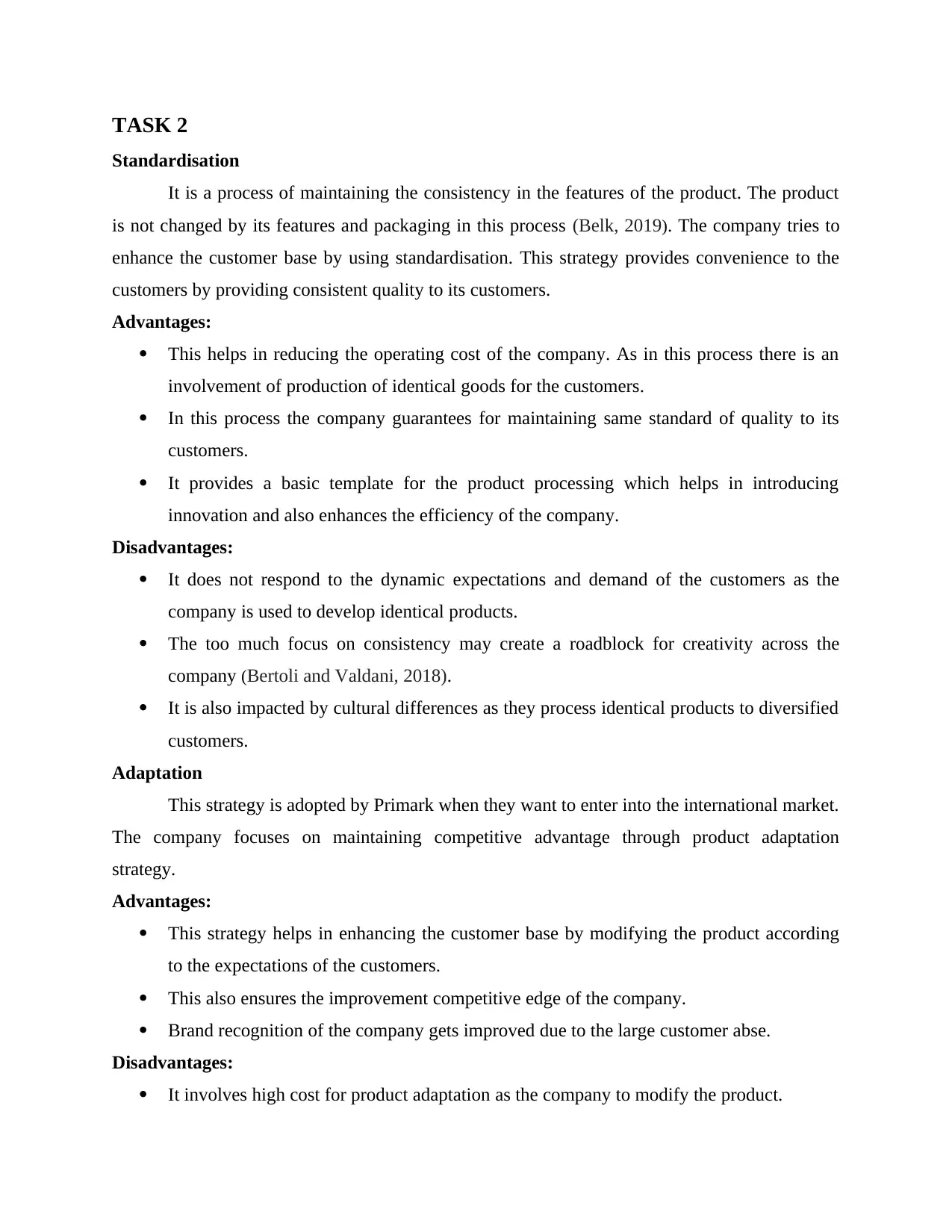
TASK 2
Standardisation
It is a process of maintaining the consistency in the features of the product. The product
is not changed by its features and packaging in this process (Belk, 2019). The company tries to
enhance the customer base by using standardisation. This strategy provides convenience to the
customers by providing consistent quality to its customers.
Advantages:
This helps in reducing the operating cost of the company. As in this process there is an
involvement of production of identical goods for the customers.
In this process the company guarantees for maintaining same standard of quality to its
customers.
It provides a basic template for the product processing which helps in introducing
innovation and also enhances the efficiency of the company.
Disadvantages:
It does not respond to the dynamic expectations and demand of the customers as the
company is used to develop identical products.
The too much focus on consistency may create a roadblock for creativity across the
company (Bertoli and Valdani, 2018).
It is also impacted by cultural differences as they process identical products to diversified
customers.
Adaptation
This strategy is adopted by Primark when they want to enter into the international market.
The company focuses on maintaining competitive advantage through product adaptation
strategy.
Advantages:
This strategy helps in enhancing the customer base by modifying the product according
to the expectations of the customers.
This also ensures the improvement competitive edge of the company.
Brand recognition of the company gets improved due to the large customer abse.
Disadvantages:
It involves high cost for product adaptation as the company to modify the product.
Standardisation
It is a process of maintaining the consistency in the features of the product. The product
is not changed by its features and packaging in this process (Belk, 2019). The company tries to
enhance the customer base by using standardisation. This strategy provides convenience to the
customers by providing consistent quality to its customers.
Advantages:
This helps in reducing the operating cost of the company. As in this process there is an
involvement of production of identical goods for the customers.
In this process the company guarantees for maintaining same standard of quality to its
customers.
It provides a basic template for the product processing which helps in introducing
innovation and also enhances the efficiency of the company.
Disadvantages:
It does not respond to the dynamic expectations and demand of the customers as the
company is used to develop identical products.
The too much focus on consistency may create a roadblock for creativity across the
company (Bertoli and Valdani, 2018).
It is also impacted by cultural differences as they process identical products to diversified
customers.
Adaptation
This strategy is adopted by Primark when they want to enter into the international market.
The company focuses on maintaining competitive advantage through product adaptation
strategy.
Advantages:
This strategy helps in enhancing the customer base by modifying the product according
to the expectations of the customers.
This also ensures the improvement competitive edge of the company.
Brand recognition of the company gets improved due to the large customer abse.
Disadvantages:
It involves high cost for product adaptation as the company to modify the product.
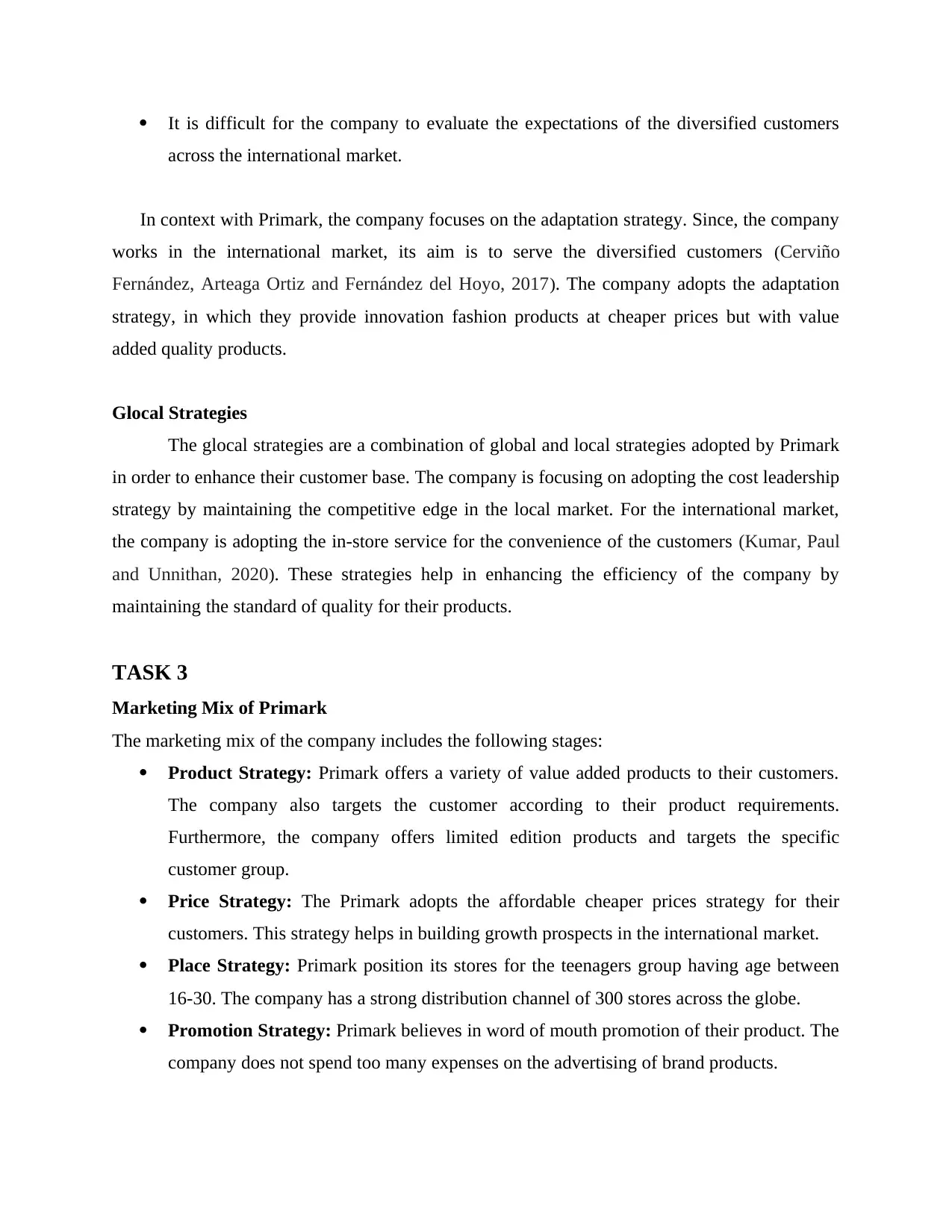
It is difficult for the company to evaluate the expectations of the diversified customers
across the international market.
In context with Primark, the company focuses on the adaptation strategy. Since, the company
works in the international market, its aim is to serve the diversified customers (Cerviño
Fernández, Arteaga Ortiz and Fernández del Hoyo, 2017). The company adopts the adaptation
strategy, in which they provide innovation fashion products at cheaper prices but with value
added quality products.
Glocal Strategies
The glocal strategies are a combination of global and local strategies adopted by Primark
in order to enhance their customer base. The company is focusing on adopting the cost leadership
strategy by maintaining the competitive edge in the local market. For the international market,
the company is adopting the in-store service for the convenience of the customers (Kumar, Paul
and Unnithan, 2020). These strategies help in enhancing the efficiency of the company by
maintaining the standard of quality for their products.
TASK 3
Marketing Mix of Primark
The marketing mix of the company includes the following stages:
Product Strategy: Primark offers a variety of value added products to their customers.
The company also targets the customer according to their product requirements.
Furthermore, the company offers limited edition products and targets the specific
customer group.
Price Strategy: The Primark adopts the affordable cheaper prices strategy for their
customers. This strategy helps in building growth prospects in the international market.
Place Strategy: Primark position its stores for the teenagers group having age between
16-30. The company has a strong distribution channel of 300 stores across the globe.
Promotion Strategy: Primark believes in word of mouth promotion of their product. The
company does not spend too many expenses on the advertising of brand products.
across the international market.
In context with Primark, the company focuses on the adaptation strategy. Since, the company
works in the international market, its aim is to serve the diversified customers (Cerviño
Fernández, Arteaga Ortiz and Fernández del Hoyo, 2017). The company adopts the adaptation
strategy, in which they provide innovation fashion products at cheaper prices but with value
added quality products.
Glocal Strategies
The glocal strategies are a combination of global and local strategies adopted by Primark
in order to enhance their customer base. The company is focusing on adopting the cost leadership
strategy by maintaining the competitive edge in the local market. For the international market,
the company is adopting the in-store service for the convenience of the customers (Kumar, Paul
and Unnithan, 2020). These strategies help in enhancing the efficiency of the company by
maintaining the standard of quality for their products.
TASK 3
Marketing Mix of Primark
The marketing mix of the company includes the following stages:
Product Strategy: Primark offers a variety of value added products to their customers.
The company also targets the customer according to their product requirements.
Furthermore, the company offers limited edition products and targets the specific
customer group.
Price Strategy: The Primark adopts the affordable cheaper prices strategy for their
customers. This strategy helps in building growth prospects in the international market.
Place Strategy: Primark position its stores for the teenagers group having age between
16-30. The company has a strong distribution channel of 300 stores across the globe.
Promotion Strategy: Primark believes in word of mouth promotion of their product. The
company does not spend too many expenses on the advertising of brand products.

Product Life Cycle
The PLC of the Primark can be explained as follows:
Introduction Stage: In this stage the Primark have introduced its makeup products in
2014 for enhancing their customer base by targeting the females of the customer group.
Growth Stage: This stage is identified when there is an enhancement in their customer
base and in their growth prospects. The company focuses on providing quality products at
cheaper prices.
Maturity Stage: This stage is evaluated in respect of the company as they have earned
the maximum level of profit by selling their products locally and globally (Magnani and
Zucchella, 2019).
Decline Stage: This stage considered when the company comes in a position of when
they reach at decreasing level of profits.
Hence, this is the product life cycle of the Company.
Boston Matrix
This matrix is known as BCG Matrix. This affects the relationship between market share and
market growth rate for the company. This model can be explained as follows:
Star Factor: This factor reflects that there is high level of growth rate and high market
share for the company. If the company achieves this factor then they will be able to
enhance their customer base (Ogasavara, Boehe and Cruz, 2016).
Question Mark: At this stage the company have high growth rate and low market share.
Primark will have to do investments for the development of the products to achieve high
market share.
Cash Cow: In this the company have low growth rate and high market share.
Dog: At this stage the company have low growth rate and low market share. The
company must utilise the resources effectively to enhance their growth prospects.
CONCLUSION
From the above report it can be concluded that international marketing is essential for the
development of the company. E-commerce provides many opportunities to the company for
The PLC of the Primark can be explained as follows:
Introduction Stage: In this stage the Primark have introduced its makeup products in
2014 for enhancing their customer base by targeting the females of the customer group.
Growth Stage: This stage is identified when there is an enhancement in their customer
base and in their growth prospects. The company focuses on providing quality products at
cheaper prices.
Maturity Stage: This stage is evaluated in respect of the company as they have earned
the maximum level of profit by selling their products locally and globally (Magnani and
Zucchella, 2019).
Decline Stage: This stage considered when the company comes in a position of when
they reach at decreasing level of profits.
Hence, this is the product life cycle of the Company.
Boston Matrix
This matrix is known as BCG Matrix. This affects the relationship between market share and
market growth rate for the company. This model can be explained as follows:
Star Factor: This factor reflects that there is high level of growth rate and high market
share for the company. If the company achieves this factor then they will be able to
enhance their customer base (Ogasavara, Boehe and Cruz, 2016).
Question Mark: At this stage the company have high growth rate and low market share.
Primark will have to do investments for the development of the products to achieve high
market share.
Cash Cow: In this the company have low growth rate and high market share.
Dog: At this stage the company have low growth rate and low market share. The
company must utilise the resources effectively to enhance their growth prospects.
CONCLUSION
From the above report it can be concluded that international marketing is essential for the
development of the company. E-commerce provides many opportunities to the company for
Paraphrase This Document
Need a fresh take? Get an instant paraphrase of this document with our AI Paraphraser

increasing their boundaries across the globe. The chosen organisation focuses on the quality of
the products and satisfies the customers with the help of their cheaper value added products.
Furthermore, the report explains the product life cycle and concepts of standardisation and
adaptation in respect of the chosen company.
the products and satisfies the customers with the help of their cheaper value added products.
Furthermore, the report explains the product life cycle and concepts of standardisation and
adaptation in respect of the chosen company.
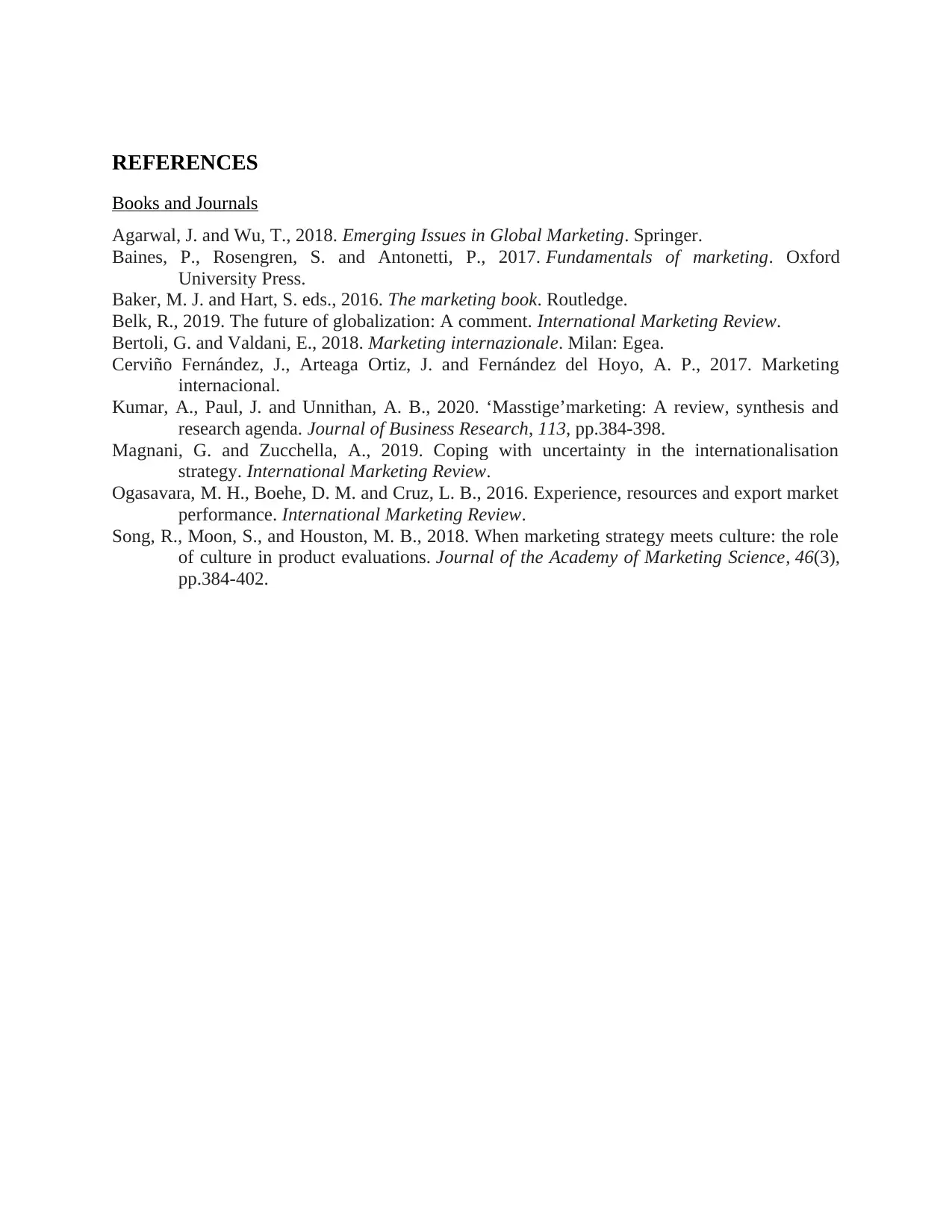
REFERENCES
Books and Journals
Agarwal, J. and Wu, T., 2018. Emerging Issues in Global Marketing. Springer.
Baines, P., Rosengren, S. and Antonetti, P., 2017. Fundamentals of marketing. Oxford
University Press.
Baker, M. J. and Hart, S. eds., 2016. The marketing book. Routledge.
Belk, R., 2019. The future of globalization: A comment. International Marketing Review.
Bertoli, G. and Valdani, E., 2018. Marketing internazionale. Milan: Egea.
Cerviño Fernández, J., Arteaga Ortiz, J. and Fernández del Hoyo, A. P., 2017. Marketing
internacional.
Kumar, A., Paul, J. and Unnithan, A. B., 2020. ‘Masstige’marketing: A review, synthesis and
research agenda. Journal of Business Research, 113, pp.384-398.
Magnani, G. and Zucchella, A., 2019. Coping with uncertainty in the internationalisation
strategy. International Marketing Review.
Ogasavara, M. H., Boehe, D. M. and Cruz, L. B., 2016. Experience, resources and export market
performance. International Marketing Review.
Song, R., Moon, S., and Houston, M. B., 2018. When marketing strategy meets culture: the role
of culture in product evaluations. Journal of the Academy of Marketing Science, 46(3),
pp.384-402.
Books and Journals
Agarwal, J. and Wu, T., 2018. Emerging Issues in Global Marketing. Springer.
Baines, P., Rosengren, S. and Antonetti, P., 2017. Fundamentals of marketing. Oxford
University Press.
Baker, M. J. and Hart, S. eds., 2016. The marketing book. Routledge.
Belk, R., 2019. The future of globalization: A comment. International Marketing Review.
Bertoli, G. and Valdani, E., 2018. Marketing internazionale. Milan: Egea.
Cerviño Fernández, J., Arteaga Ortiz, J. and Fernández del Hoyo, A. P., 2017. Marketing
internacional.
Kumar, A., Paul, J. and Unnithan, A. B., 2020. ‘Masstige’marketing: A review, synthesis and
research agenda. Journal of Business Research, 113, pp.384-398.
Magnani, G. and Zucchella, A., 2019. Coping with uncertainty in the internationalisation
strategy. International Marketing Review.
Ogasavara, M. H., Boehe, D. M. and Cruz, L. B., 2016. Experience, resources and export market
performance. International Marketing Review.
Song, R., Moon, S., and Houston, M. B., 2018. When marketing strategy meets culture: the role
of culture in product evaluations. Journal of the Academy of Marketing Science, 46(3),
pp.384-402.
1 out of 9
Your All-in-One AI-Powered Toolkit for Academic Success.
+13062052269
info@desklib.com
Available 24*7 on WhatsApp / Email
![[object Object]](/_next/static/media/star-bottom.7253800d.svg)
Unlock your academic potential
© 2024 | Zucol Services PVT LTD | All rights reserved.



